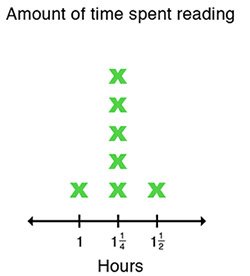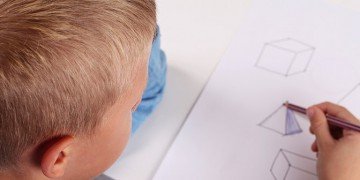Why does math matter? It’s a question your fifth grader will likely ask at some point. So here’s what to tell your fifth grader: without math we wouldn’t understand gravity. Math is behind nearly every game-changing scientific discovery. Isaac Newton, spoofed in cartoons for developing the theory of gravity after an apple fell on his head, was a mathematician.
Here are the 8 key skills your child should learn by the end of fifth grade math:
- Writing simple numerical expressions and equations using parentheses ( ) and brackets [ ].
- Working with decimals and rounding decimals to the thousandths place.
- Adding and subtracting fractions and mixed numbers with different denominators (the bottom numbers).
- Multiplying and dividing fractions.
- Dividing with two-digit divisors.
- Converting units of measurement within the same system, such as feet and inches, kilometers and meters.
- Interpreting data and analyzing relationships, such as speed and distance traveled, by creating simple equations, tables, graphs, and line plots.
- Understanding volume and finding the volume of three-dimensional shapes.
Basic equations
Math problems become a little more sophisticated in fifth grade. Instead of a simple 5 x 8 or 46 + 37, equations have multiple parts. Your child will start using numerical symbols that let her know how to solve them.
For example: 3 x (51 + 97) indicates that the 51 and 97 should be added together before multiplying them by 3.
Fifth graders learn about patterns by drawing graphs and tables that show the relationship between two sets of numbers that are related.
For example: Claudine’s dog, Sunshine, runs twice as fast as Claudine. By correctly filling in the missing number on the following table, students show they understand the pattern in this numerical relationship.

It’s all about that base – base 10, that is
Fifth graders work a lot with decimals, which are a different way of writing fractions where the denominator is always a 1, 10, 100, or 1,000. Students already understand place value for whole numbers. For example, in the number 429, the 9 is in the ones place, the 2 is in the tens place, and the 4 is in the hundreds place. On the other side of the decimal point, place value keeps decreasing by one-tenth for each place you move to the right. For example, in the number 1.234, the 2 is in the tenths place, the 3 is in the hundredths place, and the 4 is in the thousandths place. Your child will learn to read and write decimals to the thousandths and write them as numbers, in base 10, and in expanded form.
For example: 726.938 = (7 x 100) + (2 x 10) + (6 x 1) + [9 x ( 1⁄10)] + [3 x ( 1⁄100)] + [8 x ( 1⁄1000]
In expanded form, 726.938 = seven hundred twenty-six and nine hundred thirty-eight thousandths.
Your child will also learn to add, subtract, multiply, and divide decimals to the hundredths. And when they find their answer, they’ll often be asked to round decimals to the nearest one, tenth, hundredth, or thousandth.
For example: .487 can be rounded out to the hundredths place, .49, or to the tenths place, .5.
There’s also a little more to division this year. Fifth graders will divide whole numbers with up to four digits by two-digit numbers and get numbers with remainders or answers with decimals.
For example: 1,610 ÷ 80 = 20 R1 or 20.125.
Fun with fractions
In fourth grade, your child should’ve mastered how to find common denominators (the bottom numbers) in fractions. This year, fifth graders use that skill to add and subtract fractions and mixed numbers with different denominators.
For example: 4 4⁄5 – 3 2⁄3 = 4 12⁄15 – 3 10⁄15 = 1 2⁄15.
Your child will also be expected to solve word problems containing fractions and mixed numbers with different denominators.
For example: There are two pies. Mary eats 5/8 of one and Jack eats 1/3 of the other. How much pie remains? To answer this, your fifth grader has to find the common denominator for eight and three, add the fractions, then subtract what they ate from the total to see how much is left.
2 – ( 5⁄8 + 1⁄3) = 2 – ( 15⁄24 + 8⁄24) = 2 – 23⁄24 = 1 1⁄24 pies left.
Fifth graders learn to multiply two fractions, like 1⁄2 x 1⁄2, and to multiply a fraction by a whole number, like 1⁄3 x 12. Students need to learn why it is that when multiplying a whole number greater than 0 and a fraction less than 1, the product is always smaller than the whole number.
For example: 2 x 2⁄3 = 2⁄1 x 2⁄3 = 4⁄3 = 1 1⁄3 (11⁄3 is smaller than 2).
Flipping fractions
Fractions also get flipped this year as students learn that dividing fractions and whole numbers is not what it seems. For example, dividing 8 by 1⁄2 is really asking how many times 1⁄2 fits into 8. The answer is 16. On the other hand, dividing 1⁄2 by 8 asks how to break down 1⁄2 into 8 equal and smaller fractions. That answer is 1⁄16.
For example:
8 ÷ 1⁄2 = 8⁄1 ÷ 1⁄2 = 8⁄1 x 2⁄1 = 16
1⁄2 ÷ 8 = 1⁄2 ÷ 8⁄1 = 1⁄2 x 1⁄8 = 1⁄16
Measure for measure
Measurement in fifth grade is all about learning to convert from one unit of measure to another within the same system and using those conversions to solve word problems.
For example: Matthew asks for 7 ounces of milk. Adriana asks for a cup of milk. Who will get more milk?
For example: Jonathan can run one kilometer in 11 minutes. Carol can run 3 meters per second. Who is faster?
Students will also need to solve these problems with fractions and show them on a line plot.
For example: Marisa polls her classmates about how many hours they spend reading each week and shows their answers on a line plot.

Turn up the volume
Fifth graders improve their understanding of volume by learning to measure the volume of different three-dimensional shapes. In addition to counting how many unit cubes it takes to fill a shape, which they learned in fourth grade, students learn to use the formula to find the volume of a rectangular prism: V (volume) = L (length) x W (width) x H (height). Kids also learn the formula to find volume for a right rectangular prism: V (volume) = B (area of the base) x H for a right rectangular prism.

Inspire your fifth grader to work hard in math by reminding her that math helps us answer questions about the mysteries of the world — including how much chocolate fudge she’ll get if she shares that ½ box with you and her sibling, of course.
See how fifth graders in our math Milestones videos do when faced with adding and subtracting fractions with different denominators.





